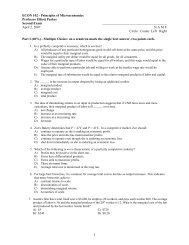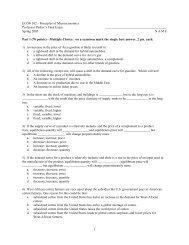ECON 102 - Principles of Microeconomics Professor Elliott Parker ...
ECON 102 - Principles of Microeconomics Professor Elliott Parker ...
ECON 102 - Principles of Microeconomics Professor Elliott Parker ...
You also want an ePaper? Increase the reach of your titles
YUMPU automatically turns print PDFs into web optimized ePapers that Google loves.
19. In a single growing season, the country <strong>of</strong> Pastoral can raise 100 tons <strong>of</strong> beef or produce 900 bushels <strong>of</strong>wheat. In the same growing season, the country <strong>of</strong> Bucolic can raise 50 tons <strong>of</strong> beef or produce 800 bushels<strong>of</strong> wheat. We then know that:A) Pastoral has the comparative advantage in raising beef.B) Pastoral has the comparative advantage in growing wheat.C) Bucolic has the comparative advantage in raising beef.D) Bucolic has the absolute advantage in raising beef.19(b). Draw PPFs for the countries <strong>of</strong> Pastoral and Bucolic, with wheat on the horizontal axes. Find the slopes,and show the production points where each specializes according to its comparative advantage. (4 points)20. If the United States placed larger tariffs on all textiles, then:A) producer surplus would increase.B) consumer surplus would decrease.C) Total surplus would decrease.D) all <strong>of</strong> the above are true.21. Suppose that an individual is risk-averse. If thisindividual's utility function is depicted in a graph,with income measured on the horizontal axis and“utils” on the vertical axis, the graph would be:A) an upward-sloping straight line through theorigin.B) an upward-sloping curve with a steadilydecreasing slope (i.e., a curve that is concavefrom below).C) an upward-sloping curve with a steadilyincreasing slope (i.e., a curve that is convexfrom below).D) an upward-sloping straight line with a positivevertical intercept.21(b) Graph this utility function.22. Risk-averse individuals are willing to pay a premium that is ______ their expected claims.A) less than C) greater thanB) equal to D) the inverse <strong>of</strong>23. An individual is considering buying shares in two different companies, A and B. For every $1,000 heinvests in A, there is a 40% probability that his investment will be worth only $800 and a 60% probabilitythat it will be worth $1,200. The corresponding risk for investment in B is identical but independent. Theprobability that he will make a loss (i.e., that his investment will be worth less than $1,000) is ______ if heinvests $2,000 in either A or B, and is ______ if he invests $1000 each in A and in B.A) 40%; 40% C) 80%; 20%B) 40%; 16% D) 40%; 80%Page 4






